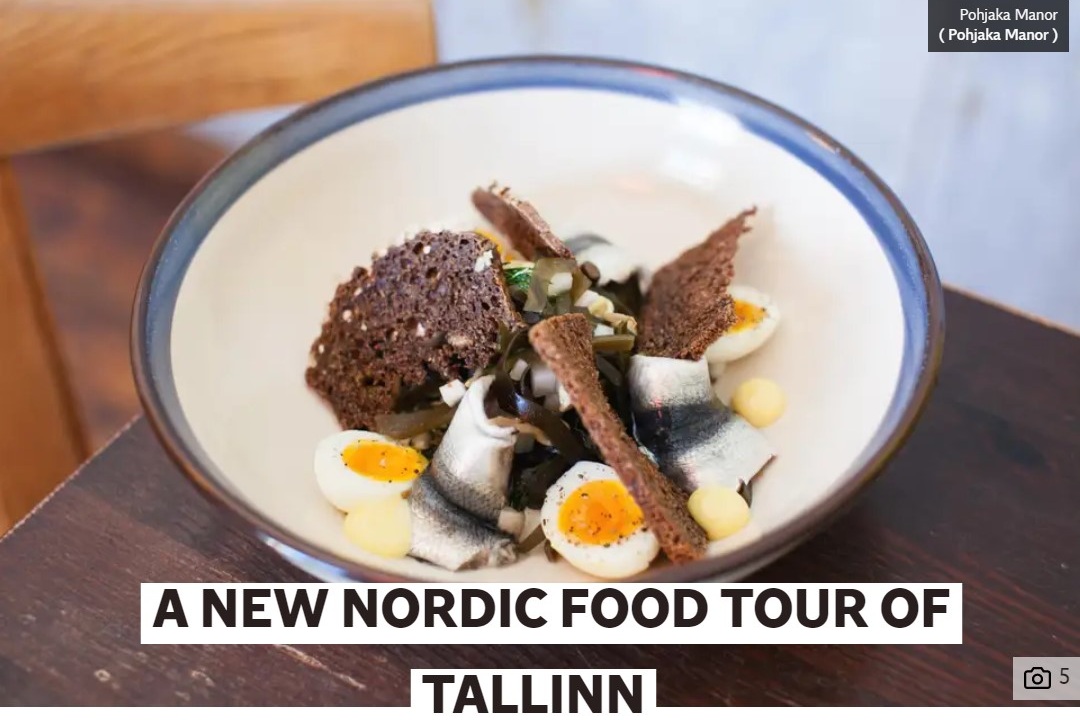On the stripped-pine table before me sits a glass bell jar. Chef Kaido Metsa lifts it and a cloud of wood smoke pours out to reveal a thick slice of almost-translucent raw white fish, topped with horseradish ice cream, pickled morel mushrooms and a scattering of foraged leaves.
I’m at Restaurant JUUR, near Tallinn’s Unesco World Heritage centre. Until a few years ago, fine dining was an alien concept in the small EU country bordered by Latvia, Russia and the Baltic Sea. Centuries of occupation by Denmark, Germany, Sweden and Russia – not to mention the Nazi and then Soviet Union rules of the 20th century – left Estonians with a diet of sauerkraut, rye bread and herring, an amalgamation of its neighbours’ cuisines.
But a new generation of chefs is spearheading an emerging food revolution in the capital and beyond, turning to the thick forest that covers 90 per cent of the country to forage for ramson berries, wild mushrooms and pine cones to be fermented and pickled just as their ancestors always did – regardless of occupying powers.
Beautifully plated and served in a Scandi-inspired space that’s all exposed brickwork and filament bulbs, the food at JUUR seems a clear nod to New Nordic cuisine – a Copenhagen-led movement led by Noma chef Rene Redzepi and characterised by immaculate presentation, foraged ingredients and a sustainable ethos. But at €60 for six courses, two-year-old JUUR offers a level of fine dining that’s not only radical in Estonia, but far more affordable than its Nordic counterparts – roughly five times cheaper than a meal at its Copenhagen counterpart.
“Salaries are low here but we’re getting more modernised and eating out more,” says Metsa, who grows vegetables, hand-makes crockery on a pottery wheel and sources 90 per cent of his ingredients within the border, advocating old-school methods as a way to celebrate Estonian food traditions.
“In the old times there weren’t refrigerators, Estonians had to cure or dry fish and meat,” he says. “Fermenting is the natural way of preserving. In the spring and autumn we gather berries and herbs and cure, dry and ferment them to use in the winter period.” Unlike in Germany or Denmark, these traditions never died down in Estonia. Cellars are still stocked with jams and pickles, and on crisp autumn days, cars line the forest edge where good mushrooms are known to grow.
But until recently, Metsa’s passion for his nation’s food culture wasn’t widely shared.
“Ten years ago, Estonians weren’t proud of their produce,” says Märt Metsallik, co-founder of countryside restaurant Põhjaka Manor, an hour’s drive from Tallinn.
“We were such a young nation and we’d been so cut off from the world, that these colourful, imported ingredients were fascinating for us. The mindset was that everything from Estonia was bad. I didn’t think so.”
With two friends, Metsallik renovated the 19th-century manor house and opened it as Estonia’s first countryside restaurant in 2010. Today, the restaurant is thriving and everything but spices and citrus fruits is sourced in Estonia, delivered by specialist farmers or grown in the kitchen garden. As for meat, much of it is game bought from local hunters controlling the populations of wild boar, elk and deer. Not only is it an ethical priority for Metsallik to support local producers (despite the sometimes-elevated cost), it’s a way to realign with the land of his ancestors, whose culinary traditions survived despite the political turmoil of the 20th century.
“The Russian and Soviet times helped preserve our traditions of foraging and preserving because there was nothing in the shops from outside Estonia,” he suggests. “You didn’t have this variety, so people made things themselves.”
Back in Tallinn, there’s one chef managing to use 100 per cent Estonian produce while stamping out the stereotype of bland Baltic food for good.
“There’s a lot to be foraged and found if you know what you’re doing,” says Martin Meikas, head chef at Restoran Ö, who relishes the creative challenge of cooking seasonally. “Cooking isn’t frying a scallop and putting some caviar on top. Anyone can do that. Cooking is inventing, taking a cabbage and making it the best it can be. Everything on this menu, you have never seen or tasted before.”
The €76 euro, 11-course tasting menu spans potato black pudding with hay-smoked cream; marinated eel with leek-infused oil, pureed artichoke and seaweed paste; beetroot-glazed goat’s curd and black garlic-infused chocolate. It’s Estonian to the core and, true to Meikas’s word, unlike anything I’ve ever experienced.
A 15-minute drive from the centre is seafront restaurant Noa, where €14 main courses demonstrate better than anywhere the affordability of fine dining in Tallinn.
“Ten years ago, Estonian cuisine didn’t exist,” claims executive chef Orm Oja, who at 27 years old was born the same year that the Soviet Union collapsed.
“Under Soviet control, restaurants had such strict rules – a chicken Kiev had to weigh 128 grams,” he says. “When the borders opened, people started to travel and experience new things, and chefs came here too.”
Oja’s menu best reflects the cultural exchange that independence brought, blending Asian techniques with home-grown ingredients: he even makes “Nordic Dim Sum” that wraps Peking duck mousse in sourdough batter. Noa’s Scandi-style dining room is modern and aspirational – not unlike its fusion menu. The chef’s dextrous approach makes it clear that the only Estonia he’s ever known is an independent one, unafraid to take influence from the outside world, while treating his entire homeland as a kitchen garden.
One thing’s certain: with Estonia’s rising Rene Redzepis at the stove, there’s never been a more exciting time to eat there. And it’s only a matter of time before the prices rise to prove it.
Travel essentials
Getting there
Wizz Air flies from London Luton to Tallinn from £30 return.
Staying there
The four-star Hotel Palace has been a fixture of Tallinn’s main square since 1937 and has an excellent on-site restaurant and pool. Doubles from £127 including breakfast.
